![]()
Terms of the Music Theory with Audio Samples
| Home | Index | Literature | Documents | Contact |
The Rhythm of the tonal music is based on the bar, which itself, in turn, has a harmonic basis. The bar is thus a derived feature of the tonal music. It emerged in the course of the harmonising of the music, to which, above all, the musical practice associated with the figured bass had contributed. With the implementation of the bar, the mensural notation evolved into the modern notation, for which the writing of bars (using bar lines) is characteristic. The aesthetics of the bar rhythm lies firstly in the bar itself, and secondly in its even hierarchical segmentation.
Bar, Harmony change
The bar is the relative sound duration of a harmony within an equable harmony sequence. The succession of consonances and dissonances, in which the tonality takes place across changing keys, occurs as an equable motion. The equability of the harmonic movement is the form in which the harmonies compare each other according to their sound duration. This form of the going together of sound figures is the starting point of an aesthetics which is called rhythm. The bar is just the, to the harmonies attached, reflex of their equable succession, hence, a typical reflex category.
The equable motion of the harmonies has four forms:
1. The absolutely equable motion. This is the main form and underlies the following forms.
2. The sporadic prolongation of the sound duration of a harmony (across a number of bars).
3. The sporadic shortening of the sound duration of a harmony (by a harmony change within the bar).
4. The change of the bar by a permanent change of the duration of the harmonies (a shorter or longer sound duration of the harmonies becomes the new standard for the subsequent bars).
The forms 2 and 3 break the equability of the harmonic motion initiated by form 1, but do not cancel it like form 4, which, on the other hand, immediately turn into form 1.
The bar notated by the use of the bar line occasionally deviates from the actually played bar for practical reasons (especially in the case of the form 4).
Notation of the bar, Bar line
Since its implementation in music, the bar is marked by bar lines. Musicians are aware that a harmony change generally takes place at the bar line. However, to draw a conclusion from the phenomenon that the sounding together of the components of a harmony usually coincides with their coexistence within the bar is more a matter for theorists. As a matter of fact, one does not notate the harmonic change, but the bar. And in the concept of the bar, there is not only the basic unity of bar and harmony included, but also their sporadic separation. The rhythmic effect of a harmony change within the bar is therefore quite properly notated if there are several harmonies between two bar lines.
However, the notation does not slavishly adhere to the audible bar. The change of bar by a tempo modification of the harmony change, for example, is only exceptionally notated as such. It is namely very important for the reading of the musical notation that the, by the bar lines delimited, bar content is defined as an always equal sound duration. Thus, two harmonies can, from a certain bar on, be in one bar without the need of having to notate a bar change. However, this convention fails to be useful if, for example, the bar is suddenly formed by three instead of four quarter notes. Then the shortening of the bar has to be indicated by a fitting notation.
The difference between the actual and the noted bar is already suggested by the bar itself and its shapes. The notation of the bar has furthermore a certain robustness against errors when judging the bar. The readability of a notation does not suffer much when, in principle, two harmonies are packed into one bar. In the case of the bar notation, the attention is not directed to the harmony change anyway, but to the accentuations, of which nobody needs to know that they are derived appearances of the bar.
In practice, the notation of bars also includes the notation of tone lengths and time signature, which, however, are based on the segmentation of the bar.
The components of the harmonies, which are the content of the bars, have a rhythmic order on the basis of an equable division of the sound duration of the bar. The bar can be divided evenly (into halves) or unevenly (into thirds), and the results of this division can, in turn, be divided (evenly or unevenly) and split into subordinate segments. The bar division occurs according to the principle of a consecutively hierarchical splitting. The equability of the splitting constitutes the accordance of the resulting segments on each level of the division and, consequently, a further shape of the fitting together of sound figures.
One can distinguish between
1. a consecutively even segmentation of the bar (example: J. S. Bach, Prelude, BWV 846)
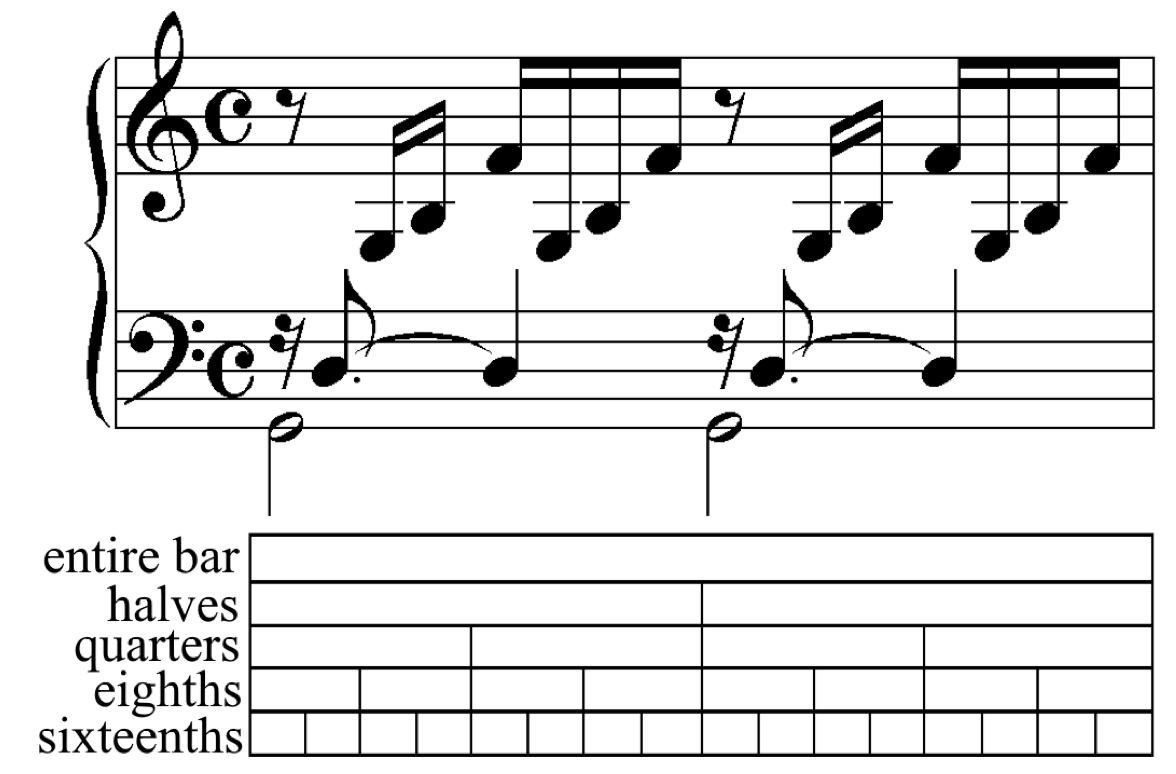
2. a consecutively uneven segmentation (example: J. S. Bach, Prelude, BWV 876)
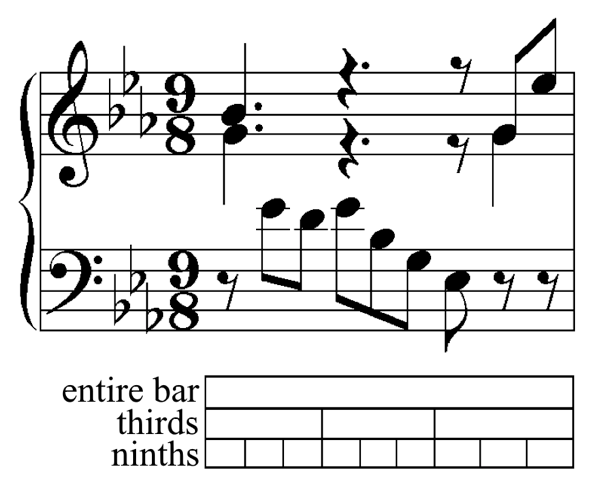
3. a combination of the division forms (examples: J. S. Bach, Prelude, BWV 999 and Gigue, BWV 825)
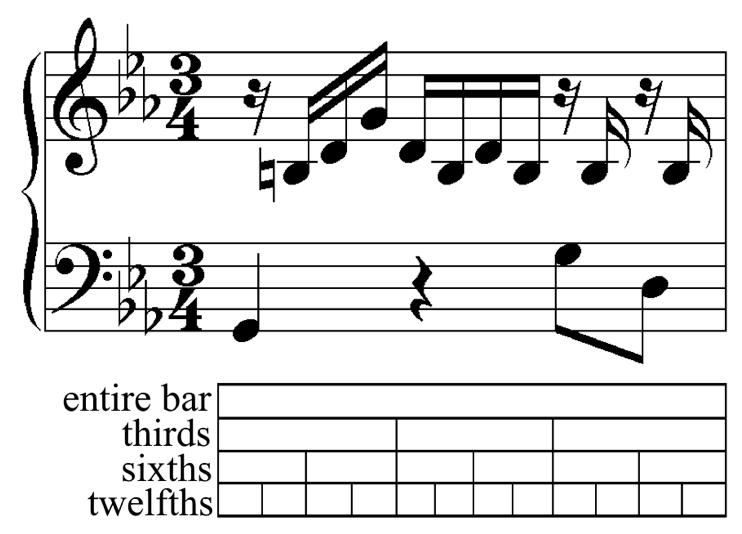
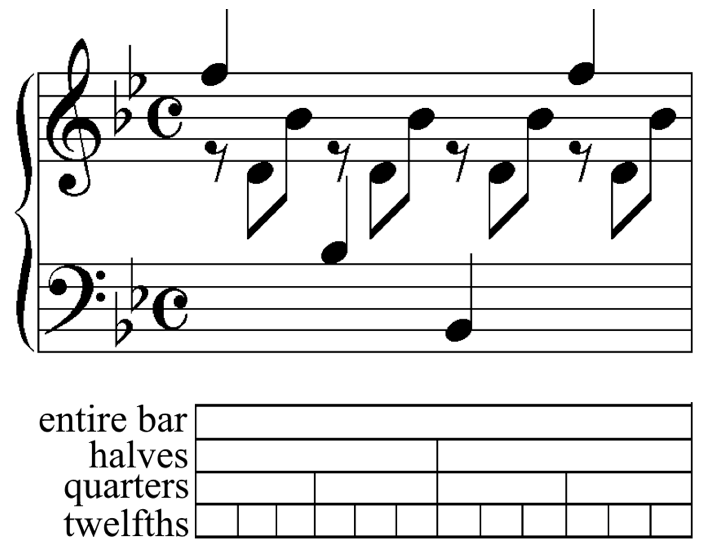
The bar segments of the various division levels occur as tones that indicate the form of the bar division, and not only for the individual bar, but also for the subsequent bars; because the bars compare themselves not only according to their sound duration, but also according to the type of their division, which thus also functions as a continuous rhythmic pattern.
On this basis, tones can also occur in which individual bar segments are fused together. They do not contribute to the consolidation of the rhythmic pattern, but are, nevertheless, defined by this pattern. Components of different harmonies or keys can be tied together into one tone by fusing several bar segments.
J. S. Bach, Variation 27 (BWV 988), bar 14/15
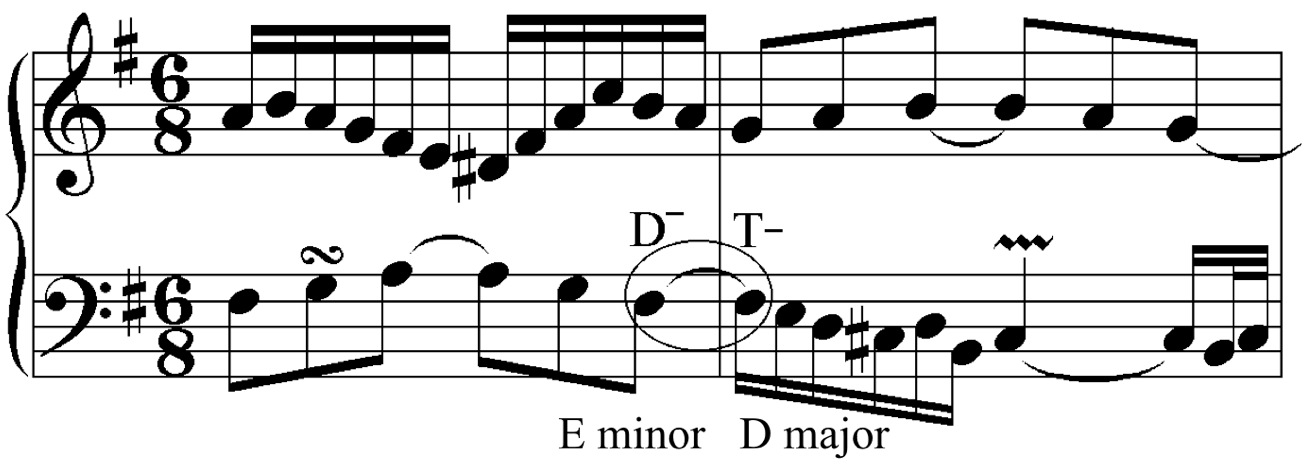
The tone F sharp which, in the bass of this note example, is tied across the bar line undergoes a harmonic metamorphosis during its sound duration where it becomes a component not only of changing harmonies, but even of changing keys. At the bar line, namely, a modulation happens from E minor to D major, as can easily be seen by the fact that both bars contain the entire tone ensemble of their respective key. The F sharp starts as a dominant fifth in E minor, then changes its harmonic identity and ends as a tonic third in D major.
Fused bar segments can be notated differently: as single notes with a certain value or as two notes with a tie (ligature).
The hierarchy of the division levels appears within the bar as a relative accentuation of the tones. In this light, the fused bar segments occur, under specific conditions, as syncopes.
With the common idea of time units from which the bar is supposed to be formed, the relationship between the bar and its parts is turned upside down.
If a musical piece begins with an incomplete bar, it can be notated in two ways:
J. S. Bach, Bourrée (BWV 807)
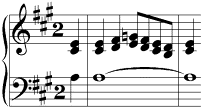
This is an example for an upbeat. It is immediately identifiable as such on the sheet of music. If the incomplete bar diverged only slightly from the bar length, rests would be notated in order to make clear the rhythmic character of the first notes. Whether an incomplete bar is notated as an upbeat or not is therefore a question of transparency on the sheet of music.
The conventional notation requires that an upbeat includes a complementary incomplete bar at the end of the musical piece, which supplements the upbeat "arithmetically" to a whole bar. The same applies to individual parts of the piece, especially if these parts are to be repeated. The repeat sign stands then in middle of the bar, that is, between the bar lines, and the complementarity of the incomplete bars ensures the rhythmic consistency and continuity of the bars.
An incomplete bar is, of course, also perceived independently of the notation, that is, when listening to music. Because, what sounds immediately before or after the bar line, differs significantly regarding the accentuation which lies at the beginning of the bar because of the harmony change.
The bar division results in a hierarchical structure of the bar, which is reflected in the tones as a relative accentuation. If, for example, the bar is divided into 16 segments, it makes a difference, whether only a new bar quarter begins, a new half or even a new bar.
J. S. Bach, Prelude (BWV 1007)
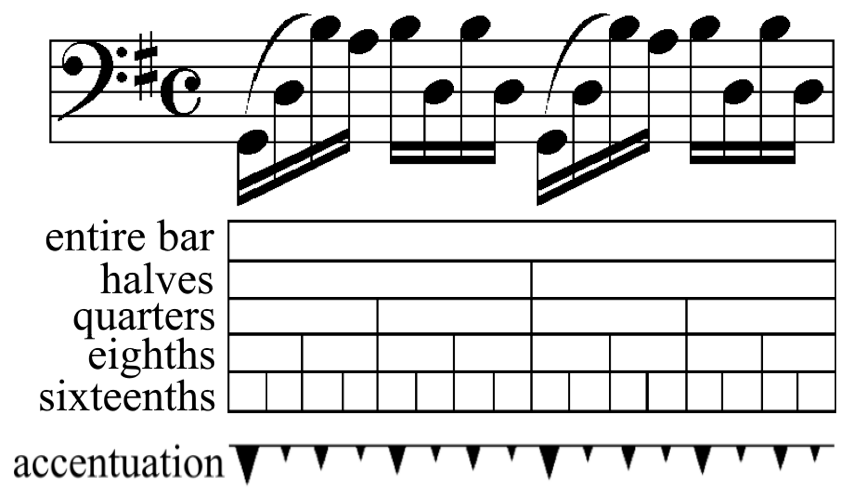
While the tones, as harmonic components and as bar segments, constitute the bar and its hierarchical structure, the rhythmical schema thus created retroacts on these tones and makes them bearers of a relative accentuation. Even the rest does not remain unaffected by this effect; this can be demonstrated by the special rhythmic effect of a rest that falls on an accentuated position such as the beginning of the bar.
If two bar segments are fused into one tone, then this resulting tone receives both of the accentuations which belong to the bar segments. This explains the rhythmic quality of the syncope.
If a number of bar segments are fused into one tone that begins with the "lighter" segment, then it receives an accentuation that is caused by the following segment. This is because the tone is a sound unit and the accentuation belongs to the tone as a whole, even if the accentuation is justified by individual rhythmic components of this tone. This results in the effect that a tone with its accentuation occurs at a point in time at which this accentuation is still in contradiction to the bar segmentation. This effect is called syncope. However, this accentuation is not noticed until the tone, in the course of its sounding, passes the heavier point in time. But the perception refers the beginning of this accentuation back to the point at which the tone itself begins. Thus, the accentuation appears, for the perception, taken back to a moment where it could not yet have been noticed at all. This ability of the perception to retroactively position the beginning of a perceived sound figure also underlies, by the way, the identification of keys and bars.
The strongest syncopations are always the ones which sound across the bar line. Whoever wants to provide transparency for the musicians, notes the syncope even otherwise by a tie:
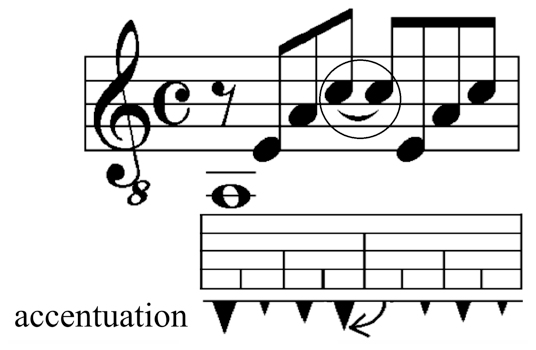
The hemiola is the presentation of short tone sequences following the pattern of primarily unevenly divided bars within a bar structure that is primarily characterised by an even bar division.
J. S. Bach, Minuetto, BWV 829, bar 8 - 12
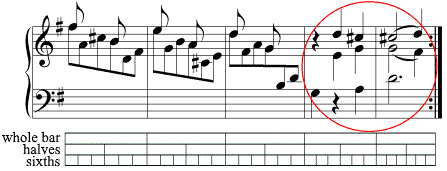
In this example, the hemiola extends across all voices and even across two bars (in the circle). This brings it a little closer to a rhythm change, which, however, would need a few more unevenly divided bars in order to make the new bar structure perceptible. The hemiola does not modify the bar segmentation as it has been established by the previous bars. The primary halving of the bars is mainly caused by tones that directly represent bar halves (in the above example, they can be seen in the upper voice). The equability of the bar and of its division characterising the rhythm and the related musical feel for the accordance of the bars cause a certain stability of the bar structure, which can only be broken by a new form of an accordance of the bars. Hence, the hemiola is a rhythmically contrary form to present bars with a primarily even segmentation. In the second last bar, the third sixth is fused with the fourth sixth of the bar so that the accentuation seems to be shifted to the front. In this (typical) case, the hemiola contains a syncope.
The lombard rhythm is the permanent change of short and long notes, with the short note lying on an accentuated position. An example:
A. Vivaldi, Violin concerto F major, 1st movement, bar 22

The longer note begins in each case on a bar segment that has the lowest weight, but is fused with the next segment and absorbs its higher weight. The longer note of the Lombard rhythm is therefore a syncope. This is particularly apparent by the following way of notating, which is rhythmically more concise:
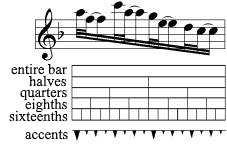
In order to show the duration of tones, the modern notation system defines relative note values which have a whole note as their starting point and are then obtained by a consecutive bisection of the note value:
![]()
By dotting a note, its duration is increased by half of its original value.
![]()
More complicated note values are presented by ligatures (ties).
The duration of a tone that is represented by a whole note is freely selectable. A musical piece is not rewritten if one wants to play it faster. On the other hand, one can (at the start of a musical piece) define the duration of a certain note as a fraction of a minute. Otherwise, the notation of tone durations is based on approximate temporal conceptions. However, the whole note must not be confused with the bar.
In this respect, there is a fundamental difference between the mensural notation, which was based on the illusion of absolute note values, and the modern musical notation, which is based on the bar. The modern note values, namely, represent bar segments which can be identified by the time signature.
Ligature, Tie
Connection between two notes in order to clarify the sound unit of a tone that is presented by two notes of the same pitch. The ligature is used for the presentation of complicated tone lengths (for example, a half note plus an eighth note), of tone lengths that extend beyond the bar limits or of syncopes.

The note values, although they represent bar segments, are not defined by the bar, but reversely: The bar is written down as an ensemble of note values. The three-four time, for example, is, in substance, a bar, whose segments form thirds of the bar. But it is presented by quarters of the whole note, three of which are combined within a bar. Or else eight quarters form one bar in order to clarify that these bars are to be played at a slower pace than an eight-eight time. In the one case, the eighth part of the bar is presented by a quarter note, in the other case by an eighth note. By notations of this kind, time signatures are specified, which are then also explicitly indicated at the beginning of the music piece for clarification purposes.
The manner to write the time signature thus defines the relation between the bar and the note values for a musical piece. This means, the bar parts are not directly marked as 1/n of the bar, but as note values which, multiplied by n, result in a bar. For example, a third of the bar is represented by a quarter note, three of which have room in one bar. This gives the semblance that the bar is not the starting point of its segmentation, but the result of a combination of pre-existing tones with a certain length. In musicology, this illusion is still kept alive by the construction of time units from which the bar is supposed to be formed. The modern notes are thus understood exactly as they were meant in the mensural notation.
While the neumatic notation and square notation were still entirely rooted in the modal music, the mensural notation was created as a form of notation for the descant, from which the tonal music has evolved. It was developed in 1280 by Franco of Cologne in order to counteract the helter-skelter singing of the nascent polyphony. The establishment of note values for precisely graded tone lengths was intended to enable a polyphony coordinated and designed on paper. The corresponding contrapuntal teachings dealt with speculations about the right way of good composing and formulated rules whose strict observance were supposed to avoid cacophony. Thereby, very gradually did a certain harmonising of the music come about, which, however, was foremost effectively driven forward by the figured bass. After the tonalisation of the music, the mensural notation became useless because it used to write endlessly continuous note values, and not bars like the modern notation where note values represent bar segments. The mensural notation was used until the beginning of the 17th century.

Figured bass, Basso continuo
The figured bass is the writing form for the style of the basso continuo, which has predominated in the 17th century. This music was based on an evenly continuous sequence of chords which were put over a tone sequence in the bass. The basso continuo was popular as an accompaniment in concert, but also as an autonomous musical style. The related notation of the figured bass consisted in the fixating of the bass notes under which the chords to be played were indicated with figures.
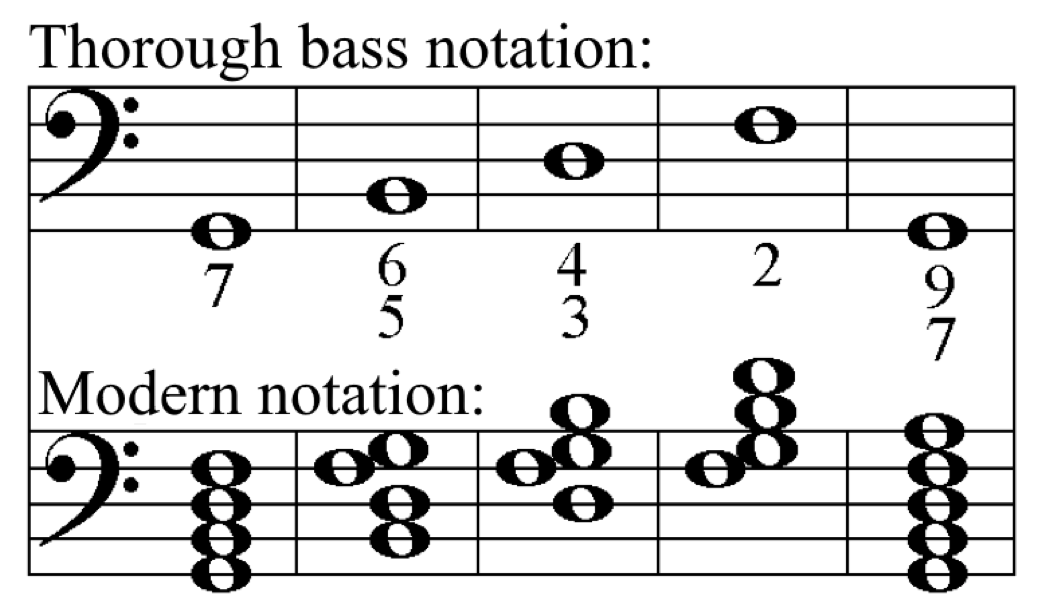
Epoch-making about the style of the basso continuo was that it made the sequence of harmonies a starting point for the composing of music. It reversed the standpoint that the old counterpoint doctrines took to the harmonies, it treated the harmonies not only as a mere condition to be taken into account for the purpose of a passable voice leading, but as something that should be crucial in music and as something it could be based on. And therein precisely, it already created an archaic form of the bar.
The harmonic and rhythmic character of the music finally became so natural that it also came about in free improvisations. With this result, however, the figured bass has rendered its own starting point superfluous: With the introduction of the bar, it was no longer necessary to conceive the music by the use of the harmonies. The need arose to attach more importance to the way the harmonies were arranged and to write them down in notes, that is, to translate the figured bass into modern notation. The music that was now to be notated had a rhythmic character in principle, and the introduction of the bar line at the beginning of the 18th century took this fact into account. However, this, in general, led to the emergence of the modern notation, which is based on the bar and which can also be called the notation of the tonal music.
Time unit, Counting time, Beat
The notation of bars as ensembles of note values promotes the false idea that the bar is nothing else than the combination of smaller units from which it is supposed to be formed. The metric "units" themselves are not understood as segments (results of a division), but as elements from which the bar is supposed to result. As such, they are called time units, beats or counting times; and Hugo Riemann claims to have found out that such a unit takes "a little less than 3/4 of a second" (System der musikalischen Rhythmik und Metrik, Leipzig 1903, p. 5). The "time units" postulated in this context are a theoretical absurdity because they are supposed to define a periodic process (as it appears in the bar). Real units of time (for example second, day etc.) are, in rational theories (for reasons of competence: in physics), conversely defined by periodic processes.
| © 2020 Franz Sauter, Hamburg | Data Protection |